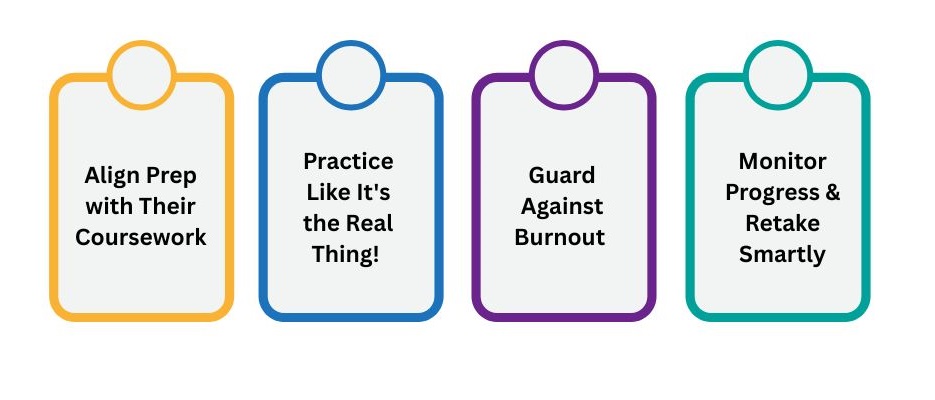Is your child preparing for the SAT and hoping to achieve that high score? Firstly, it’s totally normal to feel a bit of second-hand anxiety about your child’s performance and what it means for their college dreams. So take a deep breath and let us walk you through the best times for your child to tackle the SAT, making sure they feel prepared and confident every step of the way. Think of this as a roadmap to help ease those worries!
We advise hundreds of high-schoolers each year on the ideal strategy for timing their SAT so they can significantly enhance their performance and college admission prospects.
When Should You Take the SAT?
1. The Sweet Spot: Junior Year (11th Grade)
Most high schoolers find their rhythm with the SAT during their junior year. This is usually when they’ve built a strong foundation in their classes, especially in math and English, which are key for the test.
• Spring of 11th Grade
This is the golden window that most experts, including the folks who create the SAT (the College Board), suggest for your child’s first attempt. Why? Because by March or May of 11th grade, your child will have likely covered all the essential math topics like Algebra II and Geometry, along with the English concepts tested. This means they’ll be walking into the test center with all the right tools in their belt!
• Fall of Junior Year: An Early Bird Option
If your child is a bit of a math whiz and has already zipped through Algebra II and early Geometry, taking the SAT in August or September of their junior year can be a really smart move. Think of it as a low-pressure practice run! If they’ve already prepped for the PSAT, this can feel like a natural next step and takes some of the pressure off later. It’s all about finding what feels right for them.
2. Sophomore Year (10th Grade): For the Go-Getters!
Sometimes, we see incredibly advanced students who are ready for the SAT in 10th grade. If your child has truly mastered the core coursework, especially Algebra II, an early attempt could potentially lead to a great score. However, it’s super important not to rush it. Jumping in before they’re truly ready can lead to frustration and feeling like time was wasted, and we definitely don’t want that!
3. Senior Year (12th Grade): The Final Push!
Grade 12 a.k.a Senior year is that last crucial window to fine-tune their SAT score and make their college applications shine.
• September of Senior Year: Perfect for a Re-take!
If your child’s score from junior year wasn’t quite what they hoped for, September / October of senior year is an ideal time for a re-take. These test dates usually align perfectly with early decision and early action deadlines, meaning their improved score can still make a big splash with their dream colleges!
• December/January of Senior Year: The Last Call!
Taking the SAT during December or even January is still perfectly acceptable for regular decision applications. Just a little heads-up: it’s extra important to make sure scores are reported quickly during this time, as there can sometimes be processing delays. We want to make sure their hard work gets to the colleges on time!
Key Planning Considerations
The SAT is offered seven times a year, which gives your child plenty of flexibility for preparation, taking the test, and even re-taking it if needed. As a parent, you can think of the below tips as your personal planning guide:

• Knowing When the SAT Is Offered
The SAT usually rolls around in August, October, November, December, March, May, and June. It’s always a good idea to check the exact dates early on the College Board website. This way, you can snag the test date that works best with your child’s schedule and gives them ample time to prepare. You wouldn’t want to miss out on a preferred spot, and since seats are limited at each center, ensure you plan ahead!
• Avoiding Schedule Overload
This is a big one, especially during Grade 11 ! While March can often be a somewhat lighter month for testing, May often becomes a juggling act with final exams, project submissions, AP exams, and other academic deadlines. You definitely want to help your child avoid feeling overwhelmed. It’s about finding a balance so they can truly focus on the SAT without burning out.
• Giving Scores Enough Time to Land
You’ve probably heard about college application deadlines, and they come up faster than you think! Always try to leave at least a month between your child’s SAT test date and their college application deadlines. This score buffer ensures that their hard-earned scores are processed and submitted to colleges on time, reducing any last-minute stress.
• Planning for Retakes (It’s Totally Normal!)
Here’s a little stat that might ease some worry: most students take the SAT two to three times! So if your child didn’t get their dream score in their first attempt, then don’t sweat over it.
Retakes are incredibly common and are actually encouraged. Why? Because many colleges offer things like Score Choice (where your child can send only their best scores) and superscoring (where colleges take the best section scores from different test dates to create a new, higher composite score). This means taking it more than once often leads to an even better outcome! So, don’t view a retake as a setback, but rather as another opportunity to shine.
Helping Them Shine: Prep & Performance Tips
Getting ready for the SAT isn’t just about getting a good score; it’s also about making sure your child feels calm and confident when test day arrives. Think of preparation as building a sturdy bridge to their best performance. Here are some key tips from the experts at LilacBuds (and from parents who’ve been there!) to help them truly shine:

• Align Prep with Their Coursework
This is a really smart and important strategy! Encourage your child to plan on taking the SAT after they’ve completed Algebra II and those important English classes. Why? Because the SAT tests those foundational math concepts and reading skills. By aligning their test date with their coursework, they’ll be walking into the exam with all the knowledge fresh in their minds. It’s like making sure they have all the puzzle pieces before they start putting them together! That said, do you need help fitting the SAT puzzle together? LilacBuds experts have the final pieces of the puzzle to help you ace it!
• Practice Like It’s the Real Thing!
The new Digital SAT is a bit different, and getting comfortable with it makes a huge difference. Encourage your child to use the official full-length Digital SAT practice tests. This isn’t just about answering questions; it’s about getting used to the 2-hour, 14-minute format and all the digital tools. The more they practice under real conditions, the more confident and less surprised they’ll be on test day. This being said, do you need expert help with your SAT exam practice? Feel free to reach out to LilacBuds’ coaches.
• Guard Against Burnout
This is so important for their mental well-being! Please help your child space out their testing schedule to prevent them from feeling overwhelmed. Speak to our coaches at LilacBuds, and we can help you plan this better. Try to avoid cramming SAT prep or actual test dates too close to major academic deadlines. Their Grade 11 and Grade 12 years can be intense, and we want them to feel energized, not exhausted, when they tackle the SAT. It’s all about sustainable effort!
• Monitor Progress & Retake Smartly
After their first attempt, it’s really helpful to track their section wise performance. And here’s some excellent news that often eases parents’ minds: most students actually see measurable improvements across one to two retakes, especially if they do some focused preparation in between!
Final Word
Having guided hundreds of students through their SAT journeys each year, we’ve observed clear patterns that lead to the most successful outcomes. Here’s our recommendation, honed by real experiences from families that have worked with us:
The best initial SAT score is usually obtained in the December to March window of Grade 11, possibly preceded by a September test if ready. If deadlines allow, follow that with Grade 12 – August retakes.
This timing consistently optimizes for:
- Content mastery: Students have covered the material.
- Application strategy: Scores are available for critical ED / EA deadlines.
- Reduced stress: Spacing out attempts and knowing the plan alleviates pressure.
Our goal is always for students to head off to college knowing they put their best foot forward with their SAT scores. Good luck to your child!














